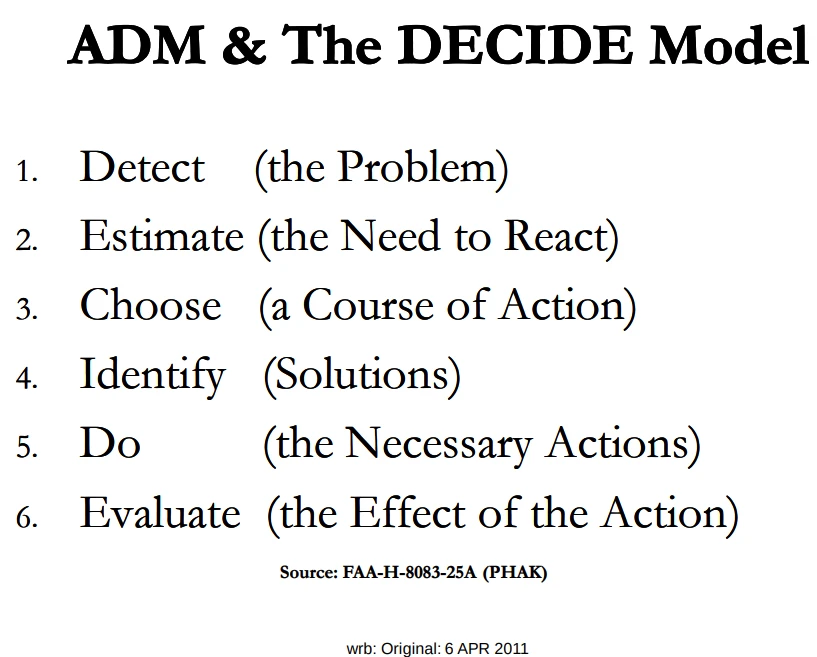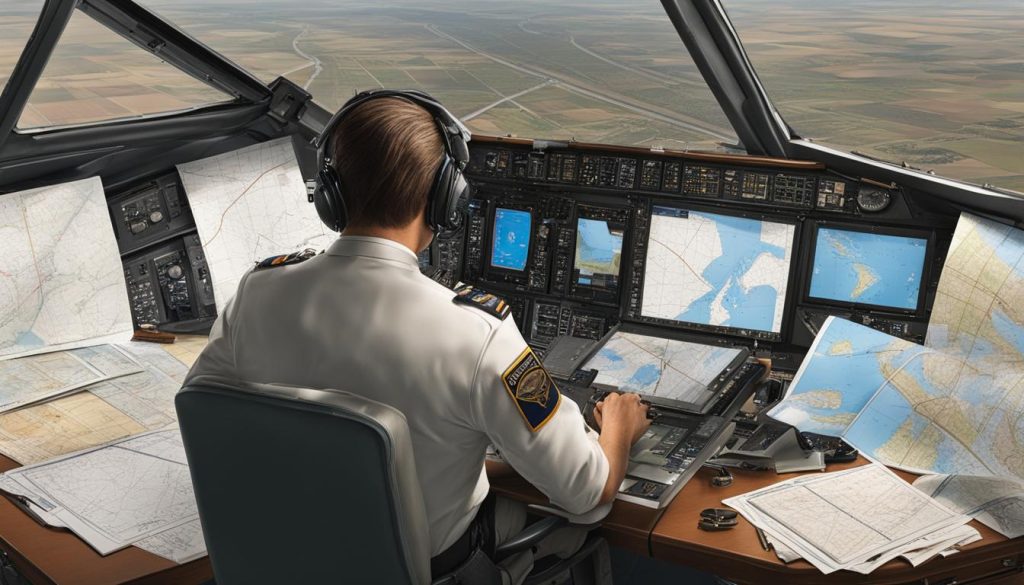Original publication date: December 13, 2023
Last Updated: 8 months
Author: Max Skyler
Topic: Proficiency
Number of Comments: 0
As a pilot, ensuring the safety of your flights is of paramount importance. In emergency situations, quick decision-making can make all the difference between a successful flight and becoming another entry in the NTSB’s Aviation Accident Database. That’s why every pilot needs to equip themselves with the DECIDE model as a critical tool in their safety arsenal.
The DECIDE model is a mnemonic acronym for a powerful decision-making checklist that provides guidance and support for pilots in mitigating critical situations that could otherwise burgeon into an emergency. Employing the DECIDE checklist therefore has the potential to, in the best case, avert a disaster, or in the worst case, salvage a situation and safeguarding the flight to a landing that you could walk away from. By following this systematic approach, pilots can effectively assess situations, make informed choices, and take appropriate actions.
With the DECIDE model, you will be equipped with a step-by-step process to handle flight emergencies and mitigate risks effectively. It helps you to detect potential problems, assess the options available to you, choose the best course of action, identify necessary resources, take prompt action, and evaluate the outcome of your decisions.
By incorporating the DECIDE model into your decision-making processes, you can enhance your ability to ensure the safety of your flights and uphold the highest standards of professionalism as a pilot.
Key Takeaways
- The DECIDE model is an essential tool for pilots to navigate emergencies and ensure flight safety.
- It provides a systematic approach to decision-making, guiding pilots through each step of the process.
- The model emphasizes problem detection, options assessment, critical decision-making, resource allocation, prompt action, and outcome evaluation.
- Pilots should undergo proper training and continuously strive for improvement in their decision-making skills.
- By following the DECIDE model and adhering to regulatory standards, pilots demonstrate their commitment to flight safety.
Understanding the DECIDE Model

The DECIDE model is an essential tool for pilots to enhance decision-making and prioritize the safety of their flights. This systematic approach provides a framework for assessing situations, making informed choices, and taking appropriate actions. By following the DECIDE model, pilots can improve their decision-making skills and ensure the safety for their passengers and crew.
The DECIDE model is an acronym that represents six crucial steps:
- Detect: This step involves detecting potential problems or risks during a flight. It requires pilots to maintain a high level of situational awareness, continuously scanning the environment for any signs of trouble.
- Estimate: Once a problem is detected, pilots need to estimate the available options and assess the associated risks. They must evaluate the severity of the problem, consider potential consequences, and weigh the possible viable courses of action.
- Choose: After evaluating the options, pilots must choose the best course of action based on factors such as weather conditions, aircraft capabilities, available resources, and regulatory requirements. The decision should prioritize the safety of the flight.
- Identify: Once the course of action is decided, pilots need to identify the necessary resources and allocate responsibilities accordingly. This step involves coordinating with air traffic control, requesting assistance, and ensuring everyone involved is aware of their roles and responsibilities.
- Do: With the course of action determined and resources allocated, pilots need to take prompt and appropriate action. This requires executing the chosen plan, following standard operating procedures, and making necessary adjustments as the situation evolves.
- Evaluate: After taking action, pilots need to evaluate the outcome of their decisions. This involves reviewing the effectiveness of the chosen course of action, assessing whether the problem has been resolved, and identifying any lessons learned for future reference.
Situations in which pilots may need to use the DECIDE model:
By diligently applying the DECIDE model, pilots can navigate through emergencies, assess risks effectively, and make sound decisions in the interest of pilot’s safety and overall flight safety.
Examples of situations where pilots might need to employ the DECIDE model:
- Failure of one or more instruments
- Inadvertent flight by a VFR pilot into IFR conditions
- Low fuel
- Communications failure
- Navigation equipment failure
- Aircraft on a collision course
- Unstable approach to landing
- Inability to maintain desired flight attitude
In an actual emergency situation, one might deem it incredulous to have to methodically deliberate over each step of the DECIDE checklist. However, taking a moment to calmly iterate through the checklist when faced with a high-pressure situation that demands immediate, but focused, attention, can make all the difference between a successful versus not-so-successful outcome.
D- Detecting The Problem
The first step of the DECIDE model is to detect the problem or potential risks. As a pilot, it is crucial to maintain a high level of situational awareness to ensure flight safety. By continuously scanning the environment, you can pick up on any signs of trouble that may arise during your flight. Being vigilant and observant allows you to quickly identify deviations or anomalies that could pose a threat.
Some things to monitor during your flight include:
- weather conditions
- instrument indications
- aircraft responsiveness
- engine performance
- changes in flight attitude
- deviation from intended course
- deviation from intended altitude
- deviation from intended heading
Being attune to your surroundings is essential. Situational awareness provides you with the necessary information to make informed decisions and take appropriate action, ultimately ensuring the safety of your flight.

Common Signs to Detect During Problem Detection
| Signs | Description |
|---|---|
| Unusual noises or vibrations | An indication of potential mechanical malfunctions or irregularities. |
| Abnormal weather patterns | Changes in wind speed, visibility, or cloud formations that could impact the flight. |
| Erratic instrument readings | Inaccurate or fluctuating data from onboard instruments, signaling potential instrument failures. |
| Unusual aircraft behavior | Unexpected movements, responses, or handling characteristics that deviate from the norm. |
| ATC communication breakdowns | Inability to establish clear communication with air traffic control or misunderstandings in instructions. |
Becoming proficient in problem detection enhances your ability to proactively address any issues, minimize risks, and maintain a high level of flight safety.
E- Estimating the Options
Once a problem is detected, you need to assess the options available to you and evaluate their associated risks. This crucial step in the decision-making process allows you to make informed choices that prioritize flight safety.
When estimating options, it is essential to assess the severity of the problem and consider the potential consequences. By carefully analyzing each option and weighing the risks involved, you can determine the best course of action to ensure the safety of your flight.
“Estimating the options allows pilots to consider various scenarios, evaluate the potential risks, and make well-informed decisions that prioritize flight safety.”
During this stage, consider factors such as weather conditions, aircraft capabilities, and available resources. By evaluating these factors, you can make a comprehensive assessment of the options and choose the most appropriate one for the situation at hand.
Remember, the goal is to minimize risks and ensure the safety of both the crew and passengers on board. By taking the time to estimate the options, you can make confident decisions that prioritize flight safety and mitigate potential hazards.
C – Choosing the Best Course of Action
After evaluating the options, it is crucial for pilots to then be able to make a well-informed decision that addresses the issue at hand, without compromising the safety of the flight. This decision-making process requires considering various factors, such as weather conditions, aircraft capabilities, available resources, and regulatory requirements.
By carefully analyzing all the relevant information, pilots can plan their course of action effectively and mitigate potential risks. Flight planning plays a vital role in ensuring the safety measures are in place and that the chosen course aligns with regulatory guidelines.
While all of this is reactive in nature, it also underscores the emphasis that absolutely must be played on pre-flight planning. Any information you may have compiled before the flight, might help aid you in making an informed decision about what course of action to take.
Information such as:
- All available information about the takeoff and destination airports, and any alternate airports en route.
- Communication frequencies.
- Navigation aids.
- Weather information.
- Airspace and obstacle clearance information.
When choosing the best course of action, it is essential for pilots to take into account the current weather conditions. Assessing factors such as visibility, wind patterns, and potential hazards enables pilots to make informed decisions that prioritize the well-being of the passengers and crew on board.
Additionally, considering the capabilities of the aircraft is crucial. Evaluating the performance limitations, range, and fuel efficiency assists pilots in determining the most suitable course that guarantees the safety and efficiency of the flight.
Furthermore, assessing the available resources is integral in decision-making. Pilots must consider factors such as available runways, emergency services, and communication facilities to ensure they have the necessary support to execute their chosen course of action effectively.
Lastly, regulatory requirements must always be factored into the decision-making process. Compliance with Federal Aviation Administration (FAA) regulations and other safety guidelines is paramount to the overall safety of the flight. Pilots should ensure that their chosen course of action aligns with these regulations to maintain the highest level of safety.
By carefully evaluating all of these factors and considering the overall flight plan, pilots can confidently choose the best course of action that prioritizes the safety of the flight, passengers, and crew.

I – Identifying Resources and Responsibilities
Once you have resolved upon a course of action, next you must identify the necessary resources and allocate responsibilities accordingly. Effective resource allocation and responsibility assignment are crucial for ensuring flight safety and the efficient execution of your chosen action plan.
This is true whether you are flying solo or as the sole pilot on board, or whether you are flying with a copilot.
Coordinating with air traffic control is essential in certain situations, especially when dealing with complex or high-pressure scenarios. By communicating your requirements and collaborating with air traffic control, you can access crucial information, such as weather updates, airspace restrictions, and alternate landing options that can greatly contribute to the safety of your flight. Worst case, you can declare an emergency if need be.
Requesting assistance from ATC or even from other pilots can also be instrumental in managing unforeseen challenges or emergencies.
When flying with another pilot on board, there is no time like an emergency during which it is imperative that both of you are aware of your roles and responsibilities in resolving the issue and getting the plane on the ground safely. This clarity helps establish effective teamwork, reduces confusion, and ensures a smooth workflow. Collaborating with your flight crew, ground personnel, and other relevant stakeholders allows for a coordinated effort that enhances safety and prevents critical errors.
Remember, efficient resource allocation and responsibility assignment enhance the overall effectiveness of your decision-making and execution processes, enabling you to navigate potential threats and ensure the safety of your flight.
| Resources Pilots Should Avail Themselves When Choosing To Carry Out An Action In Response To A Situation That Has Arisen |
|---|
| ATC |
| Electronic Flight Bag Information (Airport Facilities Directory, Weather Information, Sectional Maps) |
| Copilot (if you are flying with one) |
| Emergency Checklists |
Taking Action
Now that you have determined the course of action and allocated the necessary resources, it’s time to take action. The implementation of your chosen plan is crucial in addressing the problem at hand and ensuring the safety of your flight.
During this phase, it is important to execute the plan effectively, following the standard operating procedures that you have been trained on. Adhering to these procedures will help maintain consistency and minimize any potential errors or complications.
As you take action, it is essential to remain vigilant and adaptable. Flight situations can evolve quickly, requiring you to make necessary adjustments and decisions on the go. Stay proactive in monitoring the progress of your actions and be prepared to modify your approaches as needed.
Above all, never underestimate the importance of safety measures. Throughout the process, prioritize the safety of your flight and the well-being of all onboard. Ensure that every action you take is aligned with established safety protocols and regulations to mitigate any potential risks.
Remember, the ultimate goal is to resolve the problem at hand and resume the flight safely to landing. By taking decisive measures and staying focused on the well-being of your passengers and crew, you can successfully navigate through challenging situations and bring your flight to a safe conclusion.
Evaluating the Outcome
Once you have taken action to address the problem, it is crucial to evaluate the outcome of your decisions. This step involves reviewing the effectiveness of the chosen course of action, assessing whether the problem has been resolved, and identifying any valuable lessons learned for future reference. A thorough evaluation allows you to improve your decision-making skills and enhance your overall safety performance.
During the outcome assessment, consider the following:
- Review the effectiveness of your chosen course of action.
- Assess whether the problem has been successfully resolved.
- Identify any areas for improvement or adjustments in your decision-making process.
- Reflect on the effectiveness of your risk management strategies and safety measures.
By conducting a comprehensive evaluation, you can gain valuable insights into your decision-making process and its impact on flight safety. This analysis allows you to identify strengths, weaknesses, and areas of improvement in your decision-making skills.
Example:
| Course of Action | Effectiveness | Lessons Learned |
|---|---|---|
| Diverting to an alternate airport due to deteriorating weather conditions | Highly effective; ensured the safety of the flight and passengers | Importance of closely monitoring weather reports and proactively identifying alternate options |
| Initiating an emergency descent to address an in-flight medical emergency | Effective; provided immediate medical attention to the affected passenger | The importance of proper communication with air traffic control and coordinating with medical professionals on the ground |
| Requesting assistance from other pilots during a technical malfunction | Effective; received timely assistance and successfully managed the situation | The significance of establishing effective communication channels and fostering a collaborative environment |
By analyzing the outcome of your decisions and incorporating the lessons learned into your future decision-making processes, you can continuously improve your ability to ensure flight safety and effectively handle emergencies.
Continuous Learning and Improvement
The DECIDE model not only serves as a valuable tool for decision-making in flight emergencies but also emphasizes the importance of continuous learning and improvement. As a pilot, it is crucial to regularly review your decision-making processes and strive to enhance your skills to ensure the utmost flight safety.
To further develop your decision-making skills, seek feedback from experienced flight instructors or even professional pilots who can provide valuable insights and perspectives. Their guidance can help you identify areas for improvement and refine your approach to decision-making.
Staying updated on the latest aviation industry best practices is another essential aspect of continuous learning. Keep yourself informed about advancements in technology, regulatory changes, and safety protocols in the aviation industry. By staying current, you can incorporate new knowledge into your decision-making processes, resulting in more informed choices and improved flight safety.
Remember, learning is an ongoing process, and consistently striving for improvement is key to becoming a proficient and highly skilled pilot.
By actively engaging in the learning process and seeking opportunities for growth, you can enhance your decision-making skills and ensure that you are well-equipped to handle any future challenges that may arise during your flights.
“Learning is not attained by chance; it must be sought for with ardor and attended to with diligence.” – Abigail Adams
Key Takeaways:
- Regularly review your decision-making processes and seek feedback from experienced professionals.
- Stay updated on the latest industry best practices to incorporate new knowledge into your decision-making.
- Strive for continuous improvement to enhance your decision-making skills and ensure flight safety.
Training and Education for Pilots
To effectively utilize the DECIDE model in decision-making, pilots should undergo comprehensive training and education. Aviation authorities and training organizations offer specialized courses and drills designed to enhance decision-making skills specific to pilots. These programs focus on real-world scenarios, simulation exercises, and practical applications of the DECIDE model. By actively participating in such training, pilots can develop their decision-making abilities and become more proficient in ensuring flight safety.
The FAA offers a free online course to educate pilots on proper aeronautical decision making strategies.
Chapter 2 of the Pilots Handbook of Aeronautical Knowledge, published by the FAA, also covers this topic extensively.
Proper training equips pilots with the necessary skills to navigate challenging situations and make informed decisions that prioritize safety. Through decision-making drills, pilots can practice applying the DECIDE model and develop a systematic approach to handling emergencies and assessing risks. Regular participation in these drills allows pilots to refine their decision-making skills, build confidence, and improve overall flight safety.
Additionally, safety procedures are a fundamental aspect of pilot training. Pilots learn essential safety protocols and best practices to minimize risks and create a secure operating environment. They are trained to respond effectively to various emergencies and follow standard operating procedures. By incorporating these safety procedures into their decision-making processes, pilots can ensure the highest level of flight safety.
The Benefits of Pilot Training and Education:
- Enhanced decision-making abilities and critical thinking skills
- Improved situational awareness and risk assessment
- Effective application of the DECIDE model in real-world scenarios
- Confidence in handling emergencies and making timely decisions
- Adherence to safety procedures and regulatory compliance
By investing in training and education, pilots can continuously improve their decision-making skills and contribute to the overall safety of the aviation industry. The integration of pilot training programs and safety procedures ensures that pilots are well-prepared to handle any challenges that may arise during flight operations.
IMSAFE: Self-Assessment For Pilot Fitness To Fly
The FAA is big on mnemonic acronyms. The best way to prepare for any unforseen eventuality starts with making a go-no-go decision to fly in the first place, while you are still on the ground. The FAA has devised the IMSAFE checklist, as a means for pilots to self-assess their fitness and readiness to fly.
Regulatory Compliance and Safety Standards
The DECIDE model is not only an effective decision-making tool for pilots but also aligns with the regulatory standards set by the FAA. It emphasizes the importance of regulatory compliance and adherence to recommended safety guidelines to ensure the highest level of flight safety.
By incorporating the DECIDE model into their decision-making processes, pilots demonstrate their commitment to regulatory compliance and maintaining the utmost safety standards. This includes following the FAA regulations and guidelines related to various aspects of flight operations, such as pre-flight checks, aircraft maintenance, air traffic control procedures, and emergency protocols.
Pilots are responsible for staying informed about any updates or changes to the FAA regulations and safety guidelines. They must ensure that their operations align with the latest standards and take the necessary steps to comply with any new requirements or procedures implemented by the FAA.
Regulatory compliance goes hand in hand with flight safety, as it helps pilots mitigate risks, prevent accidents, and maintain a safe operating environment. By upholding regulatory standards, pilots not only protect themselves and their passengers but also contribute to the overall safety of the aviation industry.
Conclusion
The DECIDE model serves as an indispensable decision-making tool in ensuring the safety of pilots during flight emergencies. By following this systematic approach, pilots can effectively navigate through critical situations, accurately assess risks, and make informed choices that prioritize the safety of their flights.
Proper training and continuous learning are crucial for pilots to enhance their decision-making skills and effectively apply the DECIDE model in real-world scenarios. By staying updated with the latest industry best practices and participating in decision-making drills, pilots can develop their abilities to handle emergency situations and ensure the utmost safety for themselves, their crew, and their passengers.
Furthermore, adherence to regulatory standards, such as those set by the FAA, is essential in maintaining flight safety. By incorporating the DECIDE model into their decision-making processes, pilots demonstrate their commitment to regulatory compliance and the highest safety standards.
FAQ
What is the DECIDE model?
The DECIDE model is a systematic approach to decision-making that pilots can use to effectively assess situations, make informed choices, and take appropriate actions.
How can the DECIDE model help pilots?
The DECIDE model helps pilots navigate through emergencies and ensure the overall safety of their flights. It provides guidance and support for conducting operations in accordance with the regulations set by the Federal Aviation Administration (FAA).
What does each letter of the DECIDE model stand for?
The DECIDE model is an acronym that stands for Detect, Estimate, Choose, Identify, Do, and Evaluate.
What is the first step of the DECIDE model?
The first step of the DECIDE model is to detect the problem or potential risks.
How do pilots estimate the available options in the DECIDE model?
Pilots estimate the available options by evaluating their associated risks and considering various factors such as weather conditions, aircraft capabilities, available resources, and regulatory requirements.
How do pilots choose the best course of action in the DECIDE model?
Pilots choose the best course of action by considering all the relevant information and prioritizing the safety of the flight.
What should pilots do after choosing the course of action in the DECIDE model?
After choosing the course of action, pilots should identify the necessary resources and allocate responsibilities accordingly.
What does taking action involve in the DECIDE model?
Taking action involves executing the chosen plan, following standard operating procedures, and making necessary adjustments as the situation evolves.
Why is evaluating the outcome important in the DECIDE model?
Evaluating the outcome allows pilots to review the effectiveness of their decisions, assess whether the problem has been resolved, and identify lessons learned for future reference.
How can pilots continuously improve their decision-making skills?
Pilots can continuously improve their decision-making skills by regularly reviewing their processes, seeking feedback from experienced professionals, and staying updated on industry best practices.
What kind of training and education is available for pilots to enhance their decision-making skills?
Aviation authorities and training organizations offer courses and drills specifically designed to enhance decision-making skills in pilots. These programs focus on real-world scenarios, simulation exercises, and practical applications of the DECIDE model.
Why is regulatory compliance important in relation to the DECIDE model?
Pilots must adhere to FAA regulations and follow recommended safety guidelines to ensure the highest level of flight safety. Incorporating the DECIDE model into decision-making processes demonstrates their commitment to regulatory compliance and maintaining safety standards.
What is the significance of the DECIDE model as a decision-making tool?
The DECIDE model is an essential tool that every pilot should have in their safety arsenal. It helps pilots effectively navigate emergencies, assess risks, and make informed choices that prioritize the safety of their flights.




